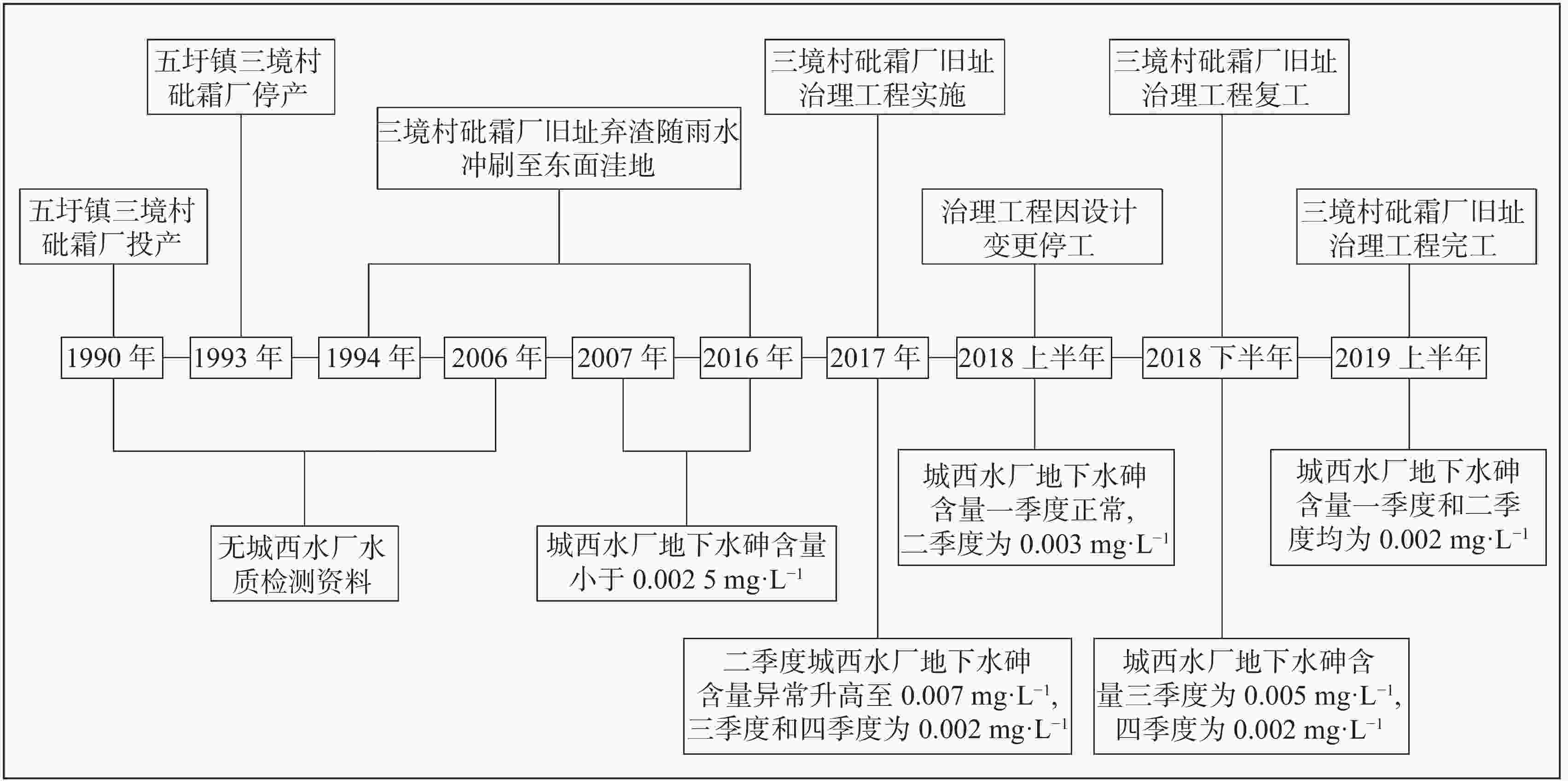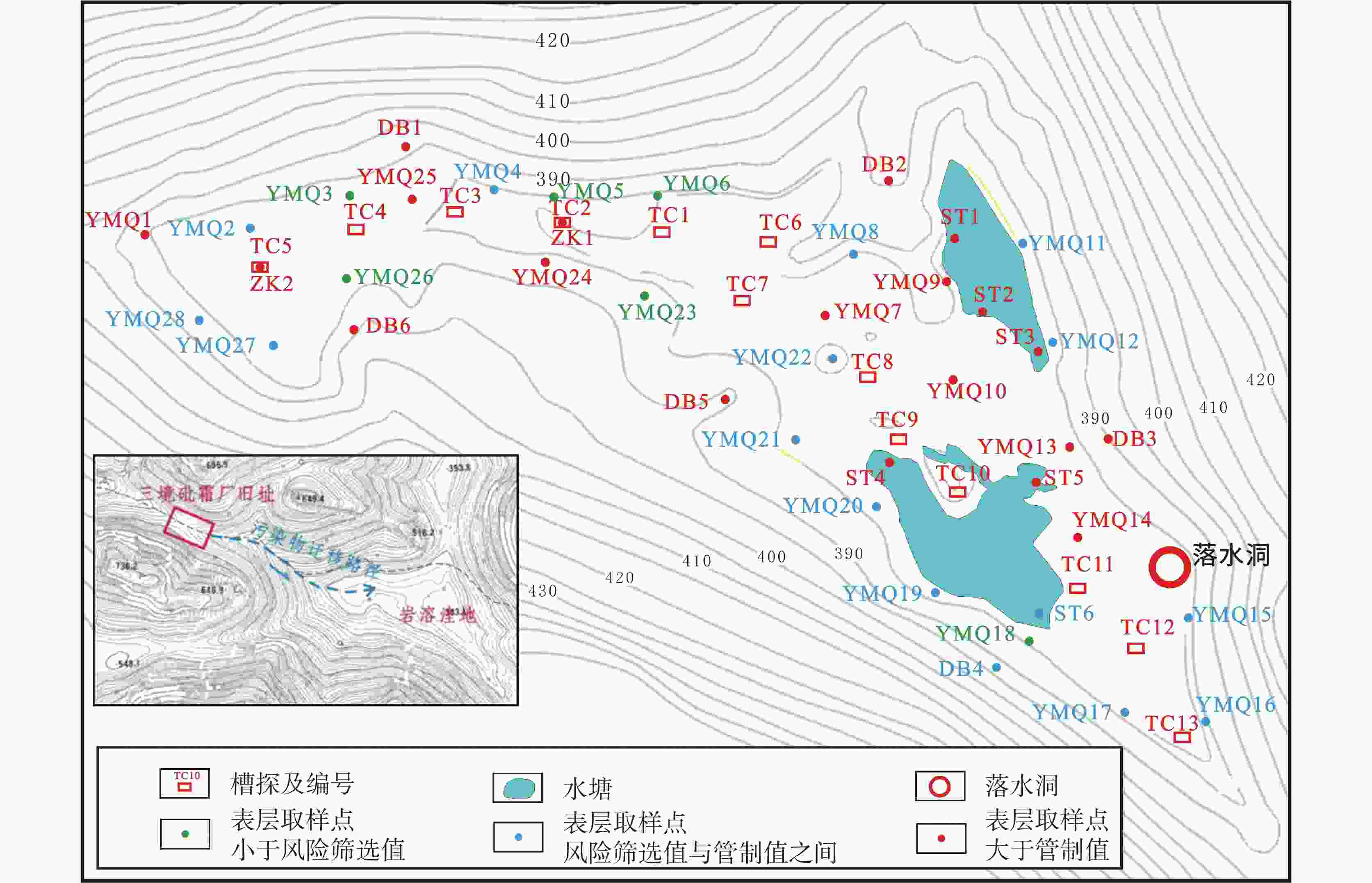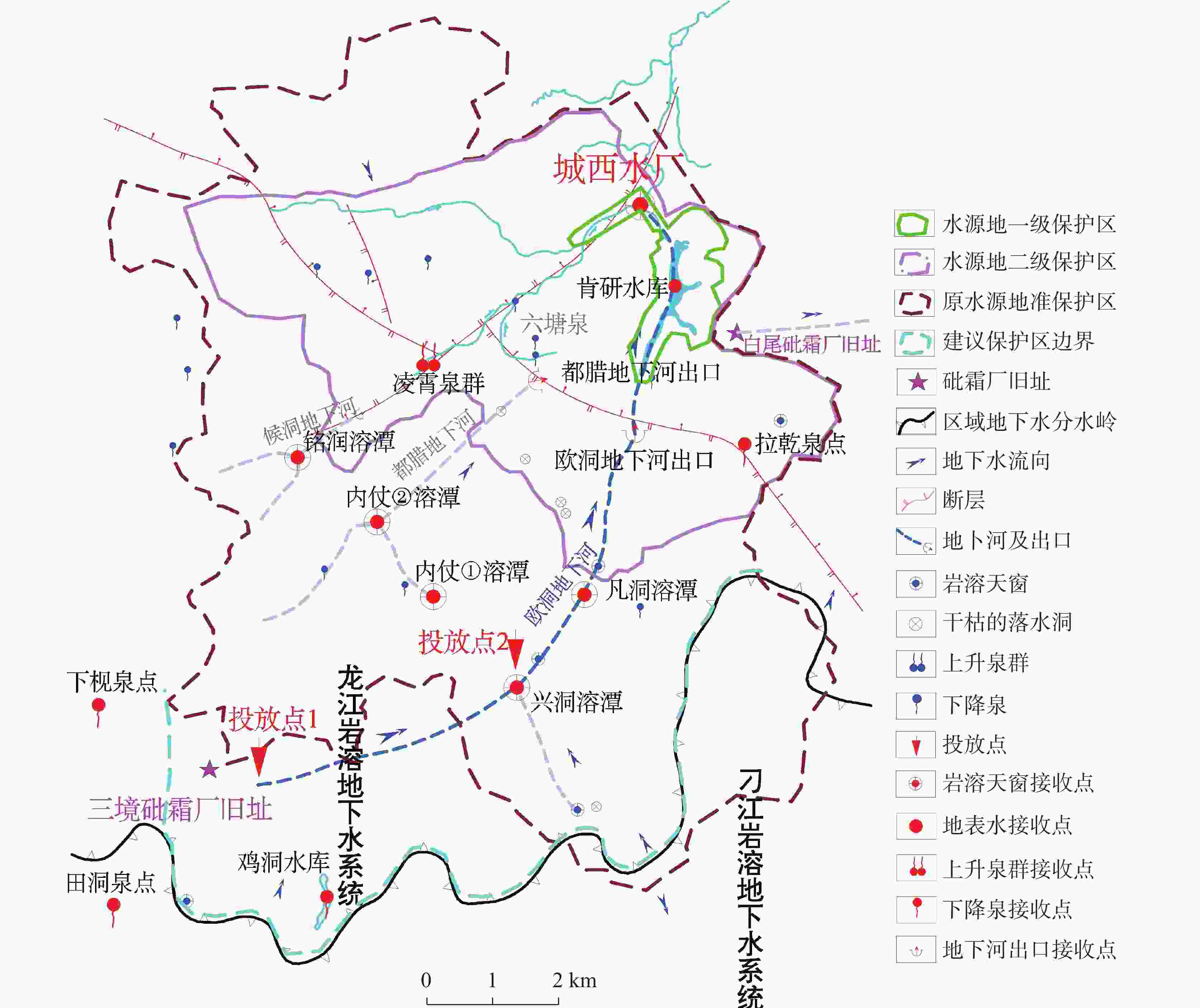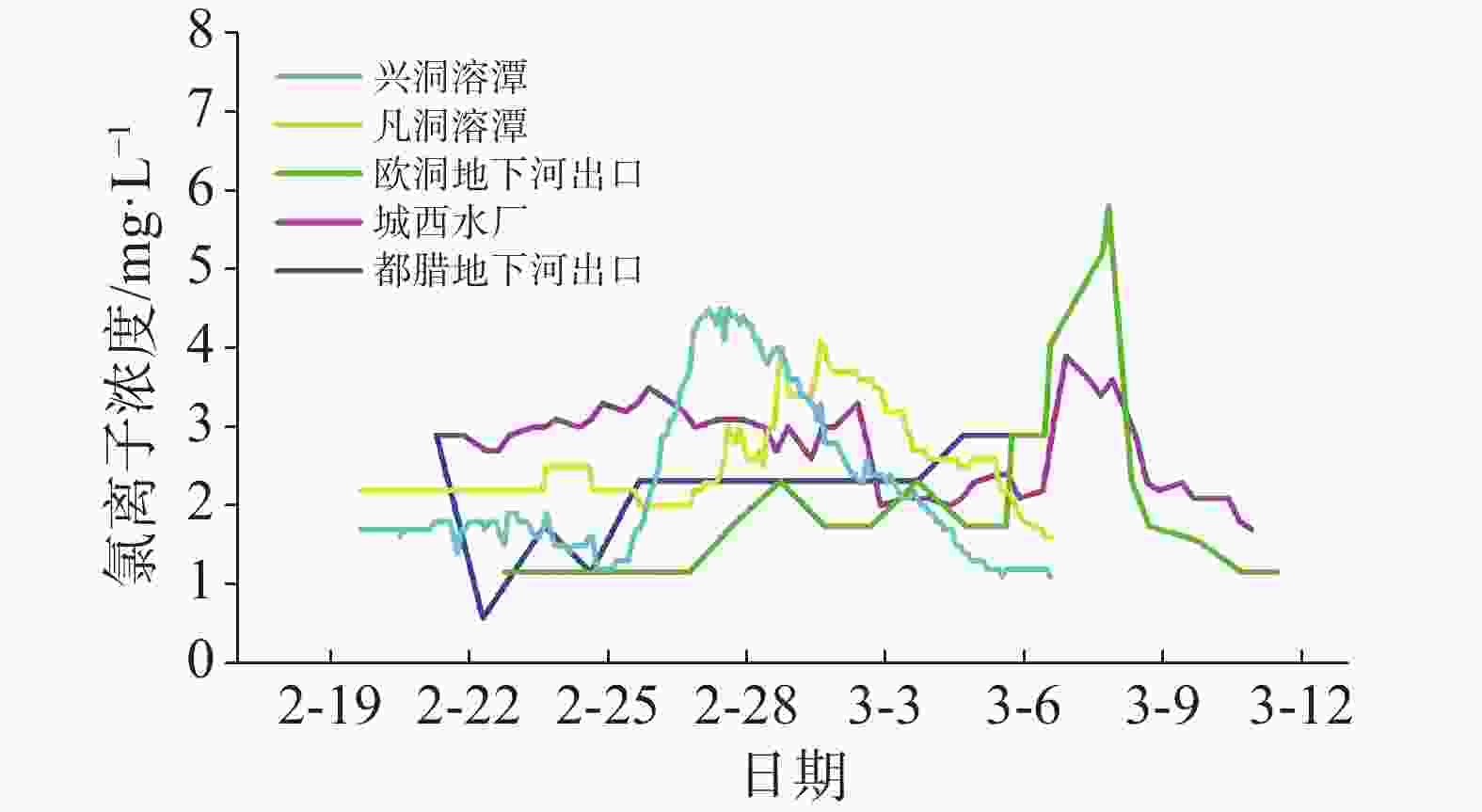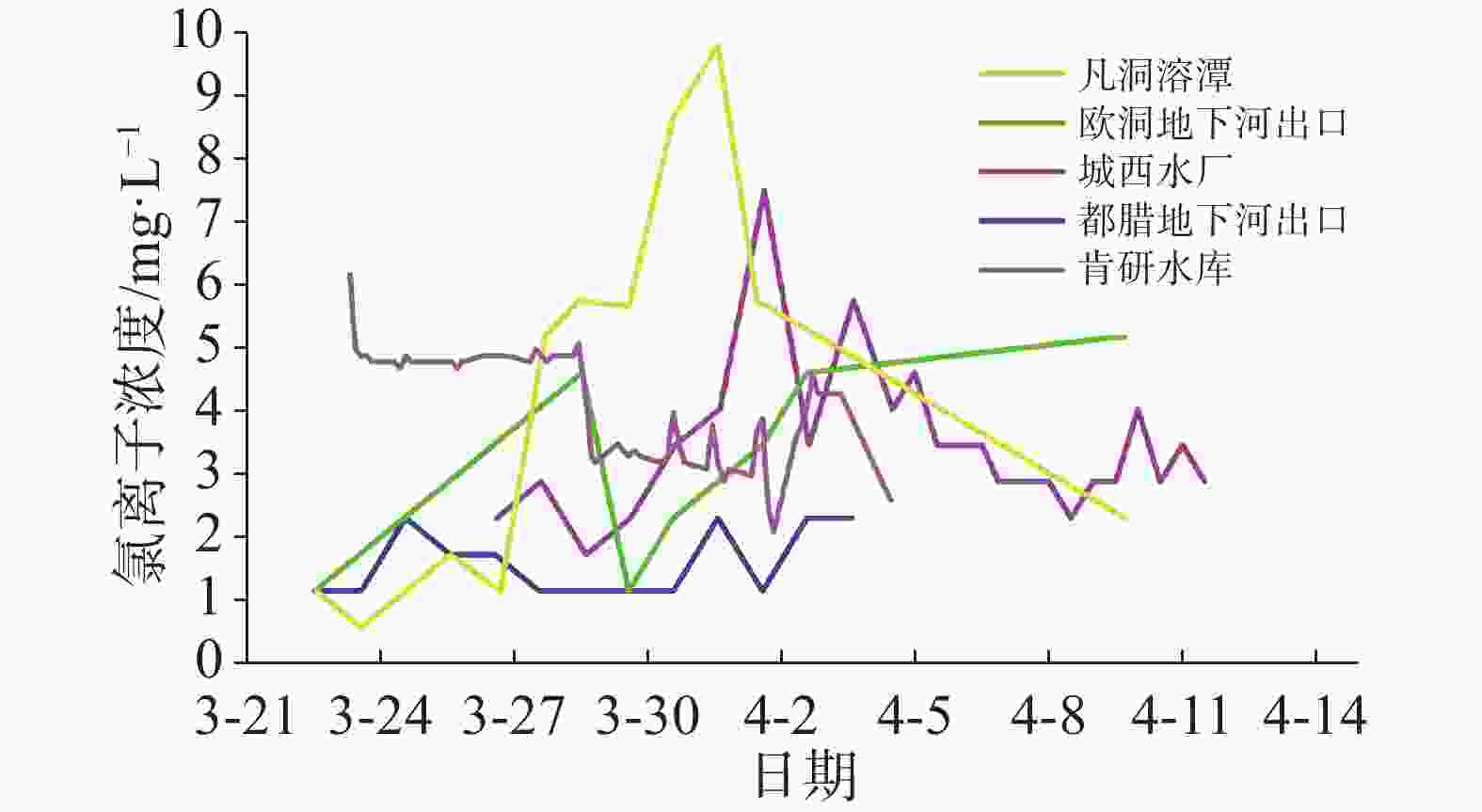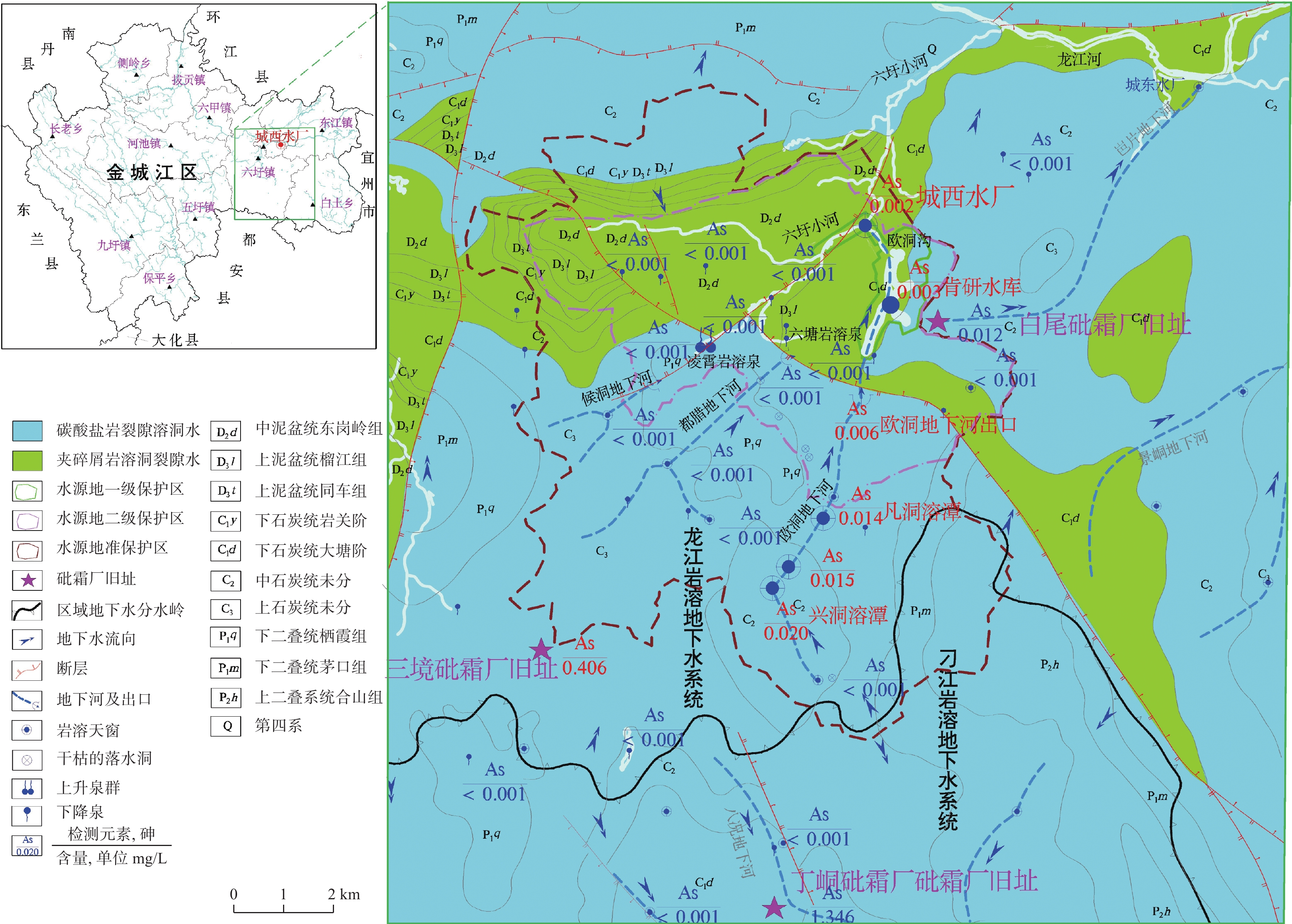Sources and pathways of arsenic pollution in the karst water source area in the west of Jinchengjiang district, Hechi City
-
摘要: 为研究岩溶水源地污染物来源和运移途径,以河池市金城江区城西水厂岩溶水源地为研究区,依据水文地质学分析方法,开展城西水厂砷异常原因调查,利用示踪试验和取样检测等手段,查明砷污染源处于城西水厂水源地准保护区范围外,为三境村砒霜厂旧址及其东面岩溶洼地,并评估出砷污染土层方量为55 742.5 m3,其污染途径长12.25 km,主要通过岩溶管道,经欧洞地下河污染城西水厂,这进而证实欧洞地下河的另一水源方向。建议调整城西水厂水源地准保护区南部边界,以地下水分水岭为界,并适当增设水质长期监测点,以实施污染源风险管控。Abstract:
Karst groundwater is an important water resource in karst areas of China and even the world, which plays an important role in people's life and industrial and agricultural production. A karst aquifer is composed of interconnected karst pores, cracks, caves, pipelines and other multiple media, which has strong capabilities for water collection, storage and drainage. Because soil layers in karst areas are generally thin, pollutants can directly enter groundwater aquifers through soil layers, sinkholes and karst cracks, which makes karst groundwater extremely vulnerable to pollution. Due to several reasons in the past, some old industrial slag yards were built on karst caves and cracks, but no effective anti-seepage measures were taken. Many incidents of karst groundwater pollution caused by leakage of slag piles occurred in China. In order to study the characteristics of sources and transporting routes of pollutants in karst underground water sources, this study took the karst water source of Chengxi water plant in Jinchengjiang district, Hechi City as a study area. By investigating the causes of arsenic anomalies in this plant and conducting hydrogeological analysis, this study identified pollution sources and sampled in the contaminated site to assess the arsenic pollution sources. The sources of arsenic pollution were found out, that is, the former site of arsenic factory and the karst depression to its east in Sanjing village, Wuxu town, Jinchengjiang district. The waste slag piled on the site of Sanjing arsenic factory was alluvial with the flood in the gully and bottom depression. Under the long-term action of rain, sunlight, air and microorganisms, the waste residue underwent complex chemical reactions, releasing heavy metal ions. Leachate seeped into groundwater through sinkholes and karst cracks, forming pollution sources. Arsenic concentrations in the contaminated site range between 7.17 and 25,200 mg·kg−1, with an average concentration of 1,296.3 mg·kg−1. The area where the arsenic concentration is higher than the risk control value of other agricultural land (120 mg·kg−1) covers about 22,297 m2, with an average thickness of 2.5 m. The volume of arsenic contaminated soil is 55,742.5 m3. Two tracing tests of underground water found that arsenic flows to Chengxi water plant through underground karst runoff, and the pathway is as follows: karst depression in the east of Sanjingcun arsenic factory → Xingdong in Xingdong village of Liuwei town → Fandong → Oudong → Nalong reservoir (underground runoff zone) → Chengxi water plant. The runoff is 12.25 km long with a groundwater flow rate of 0.86 km·d−1 and a permeability coefficient of 0.995 cm·s−1. The long-term monitoring of water quality shows that the arsenic content of Chengxi water plant is at risk of exceeding the permitted level of Class III (0.01 mg·L−1) during the flood season. Therefore, it is necessary to control the pollution source (karst depression in the east of the arsenic factory) and to strengthen the monitoring of groundwater quality in the water source area of Chengxi water plant by setting up monitoring points for long-term observation of water quality at key points in the runoff area. For example, new monitoring points can be established at Lingxiao spring, estuary of Dula underground river, Xingdong skylight and Fandong skylight. The pollution source is located outside the quasi-protected area of the water source of Chengxi water plant. Considering that the water source mainly consists of karst water, and the groundwater primarily flows through karst pipelines, the pollutant runoff path is long and the attenuation is slow, it is suggested to expand the quasi-protected area of the water source of Chengxi water plant, with the southern boundary defined by groundwater divide of Longjiang karst groundwater system and Diaojiang karst groundwater system. -
Key words:
- karst area /
- groundwater /
- water source area /
- causes of pollution /
- tracer test
-
表 1 城西水厂岩溶水源地系统
Table 1. System of karst water source area of Chengxi water plant
城西水厂岩
溶水源地次级系统 介绍 都腊地下河 发源于内丈一带,从都腊地下河出口排出地表 候洞地下河 发源于勒从、铭润山庄一带,从候洞屯排出地表汇入凌霄泉地表水流 欧洞地下河 发源于兴洞村外塘屯一带,向北径流,主要通过外塘屯、兴洞屯、凡洞屯;水位高时从
欧洞屯排出地表,水位低时则通过地下岩溶管道向北径流到达城西水厂溶潭凌霄岩溶泉 在凌霄村廷榄屯遇阻水断层后,以上升泉的形式出露地表 六塘岩溶泉 发源于凉水坳一带,流量较小 表 2 历史遗留砒霜厂信息
Table 2. Information of the arsenic factory
厂名 地理位置 地下水流向分析 丁峒砒霜厂 都安县三只羊乡丁峒 厂址地表水和地下水流向南东方向,可排除丁峒砒霜厂为城西水厂污染源的可能性 白尾砒霜厂 金城江区六圩镇白尾 厂址地下水总体径流方向为北东向,可排除白尾砒霜厂为城西水厂污染源的可能性 三境砒霜厂 金城江区五圩镇三境村 厂址地表水和地下水流向北东方向(城西水厂水文地质单元方向) 表 3 采取土样信息表
Table 3. Sampling information
采样布置 编号 样品数 备注 槽探取样 TC1~TC13 65 采集深度为25 cm、50 cm、100 cm、150 cm和200 cm 浅钻取样 ZK1、ZK2 10 采样深度为300 cm、400 cm、500 cm、600 cm和650 cm 塘底取样 ST1~ST6 6 洼地水塘底部土样 洼地淹没区取样 YMQ1~YMQ28 28 布置在洼地边缘至1.5 m高的范围内周边山体,主要为控制污染源经洪水
浸泡后污染物浸出的二次污染情况周边山体取样 DB1~DB6 6 布置在洼地边缘以上6 m,主要为检测未受污染土壤砷浓度的背景值,以
及控制污染范围 -
[1] 袁道先, 朱德浩, 翁金桃, 朱学稳, 韩行瑞, 汪训一, 蔡桂鸿, 朱远峰, 崔光中, 邓自强. 中国岩溶学[M]. 北京:地质出版社, 1993. [2] 曹建文, 夏日元. 西南岩溶石山地区不同类型地下河开发利用模式探讨[J]. 中国岩溶, 2017, 36(5):609-617.CAO Jianwen, XIA Riyuan. Exploitation models for different types of underground rivers in karst mountain areas of Southwestern China[J]. Carsologica Sinica, 2017, 36(5): 609-617. [3] 杨杨, 赵良杰, 夏日元, 王莹. 珠江流域岩溶地下河分布特征与影响因素研究[J]. 中国岩溶, 2022, 41(4):562-576.YANG Yang, ZHAO Liangjie, XIA Riyuan, WANG Ying. Distribution and influencing factors of karst underground rivers in the Pearl River Basin[J]. Carsologica Sinica, 2022, 41(4): 562-576. [4] 张连凯, 杨慧. 岩溶地下河中砷迁移过程及其影响因素分析:以广西南丹县里湖地下河为例[J]. 中国岩溶, 2013, 32(4):377-383.ZHANG Liankai, YANG Hui. Transport process of arsenic in karst subterranean stream and analysis on the influence factors: A case in Lihu subterranean stream of Nandan county, Guangxi[J]. Carsologica Sinica, 2013, 32(4): 377-383. [5] 唐伟, 裴建国, 殷建军, 林玉石, 蒲俊兵, 汪智军, 朱琴. 桂林毛村岩溶地下河二十多来的水质演化趋势研究[J]. 中国岩溶, 2010, 29(3):331-336.TANG Wei, PEI Jianguo, YIN Jianjun, LIN Yushi, PU Junbing, WANG Zhijun, ZHU Qin. Water quality evolution tendency in Maocun karst underground river in Guilin for the past more than 20 years[J]. Carsologica Sinica, 2010, 29(3): 331-336. [6] 袁道先, 薛禹群, 傅家谟, 郑度, 汪集旸, 林学钰, 陈梦熊. 我西南岩溶地区地下河面临变成“下水道”威胁,加强保护和污染治理需从国家层面尽快做出决策[J]. 科学新闻, 2007(14):7-9. [7] 覃霞, 张超兰, 黎承波, 容群, 梁蕊芬, 韦仁棒, 李雪, 徐蒙蒙. 某砒霜厂场地砷污染特征及风险评估[J]. 广西大学学报(自然科学版), 2021, 46(4):1101-1109.QIN Xia, ZHANG Chaolan, LI Chengbo, RONG Qun, LIANG Ruifen, WEI Renbang, LI Xue, XU Mengmeng. Characteristics and risk assessment of soil arsenic pollution in an arsenic plant site[J]. Journal of Guangxi University (Natural Science Edition), 2021, 46(4): 1101-1109. [8] 陈舟, 赵贵清, 王志光, 陈豪, 张科正. 岩溶区某磷石膏堆放场渗漏特征分析[J]. 水文地质工程地质, 2017, 44(2):144-150.CHEN Zhou, ZHAO Guiqing, WANG Zhiguang, CHEN Hao, ZHANG Kezheng. Leakage characteristics of a phosphorus gypsum storage site in karst area[J]. Hydrogeology & Engineering Geology, 2017, 44(2): 144-150. [9] 高旭波, 王万洲, 侯保俊, 高列波, 张建友, 张松涛, 李成城, 姜春芳. 中国北方岩溶地下水污染分析[J]. 中国岩溶, 2020, 39(3):287-298. doi: 10.11932/karst2020y25GAO Xubo, WANG Wanzhou, HOU Baojun, GAO Liebo, ZHANG Jianyou, ZHANG Songtao, LI Chengcheng, JIANG Chunfang. Analysis of karst groundwater pollution in Northern China[J]. Carsologica Sinica, 2020, 39(3): 287-298. doi: 10.11932/karst2020y25 [10] Zhou Changsong, Zou Shengzhang, Zhu Danni, Xie Hao, Chen Hongfeng, Wang Jia. Pollution pattern of underground river in karst area of the Southwest China[J]. Journal of Groundwater Science and Engineering, 2018, 6(2): 71-83. [11] Manuela Lasagna, Domenico Antonio De Luca, Laura Debernardi, Paolo Clemente. Effect of the dilution process on the attenuation of contaminants in aquifers[J]. Environmental Earth Sciences, 2013, 70(6): 2767-2784. doi: 10.1007/s12665-013-2336-9 [12] 郭永丽, 吴佩艳, 黄芬, 孙平安, 苗迎, 刘绍华. 环境同位素示踪的毛村地下河流域水流特征[J]. 中国岩溶, 2022, 41(4):577-587.GUO Yongli, WU Peiyan, HUANG Fen, SUN Ping'an, MIAO Ying, LIU Shaohua. Water flow characteristics of Maocun underground river basin based on environmental isotopes[J]. Carsologica Sinica, 2022, 41(4): 577-587. [13] 程亚平, 陈余道. 岩溶地下河定量示踪研究方法综述[J]. 桂林理工大学学报, 2016, 36(2):242-246.CHENG Yaping, CHEN Yudao. Review of quantitative tracing studies on karst underground river[J]. Journal of Guilin University of Technology, 2016, 36(2): 242-246. [14] 张劲松, 杨玫. 人工示踪试验方法在岩溶地下水调查中的应用[J]. 地质论评, 2017, 63(Suppl.1):335-336.ZHANG Jinsong, YANG Mei. Applications of tracing test in karst groundwater investigation[J]. Geological Review, 2017, 63(Suppl.1): 335-336. [15] Nico Goldscheider. A new quantitative interpretation of the long-tail and plateau-like breakthrough curves from tracer tests in the artesian karst aquifer of Stuttgart, Germany[J]. Hydrogeology Journal, 2008, 16(7): 1311-1317. doi: 10.1007/s10040-008-0307-0 [16] Tanguy Robert, David Caterina, John Deceuster, Olivier Kaufmann, Frederic Nguyen. A salt tracer test monitored with surface ERT to detect preferential flow and transport paths in fractured/karstified limestones[J]. Geophysics: Journal of the Society of Exploration Geophysicists, 2012, 77(2): 55-67. [17] Brian G Katz, Tyler B Coplen, Thomas D Bullen, J Hal Davis. Use of chemical and isotopic tracers to characterize the interactions between ground water and surface water in mantled karst[J]. Groundwater, 2010, 35(6): 1014-1028. [18] Christopher Smart, Michiel Pronk, Joe Meiman, Nico Goldscheider. Tracer tests in karst hydrogeology and speleology[J]. International Journal of Speleology, 2008, 37(1): 27-40. doi: 10.5038/1827-806X.37.1.3 [19] 何师意, L Michele, 章程, 汪进良, 李强. 高精度地下水示踪技术及其应用:以毛村地下河流域为例[J]. 地球学报, 2009, 30(5):673-678.HE Shiyi, L Michele, ZHANG Cheng, WANG Jinliang, LI Qiang. A high precision underground water tracing test technique and its applications: A case study in Maocun karst system, Guilin, Guanxi[J]. Acta Geoscientica Sinica, 2009, 30(5): 673-678. [20] 王寿昌, 何羽玲, 韦增康. 某岩溶区临水基坑涌水封堵结合连通试验治理技术[J]. 施工技术, 2019, 48(13):33-35.WANG Shouchang, HE Yuling, WEI Zengkang. Technology of water gushing and plugging with connectivity test treatment of foundation excavation nearby waters in karst area[J]. Construction Technology, 2019, 48(13): 33-35. [21] 吴玉梅, 骆振华, 罗维, 宋晨, 张传良. 连通试验在西南某区岩溶地下水污染溯源中的应用[J]. 城市地质, 2023, 18(1):69-74.WU Yumei, LUO Zhenhua, LUO Wei, SONG Chen, ZHANG Chuanliang. Connectivity test to trace karst groundwater pollution sources in Southwest China[J]. Urban Geology, 2023, 18(1): 69-74. -




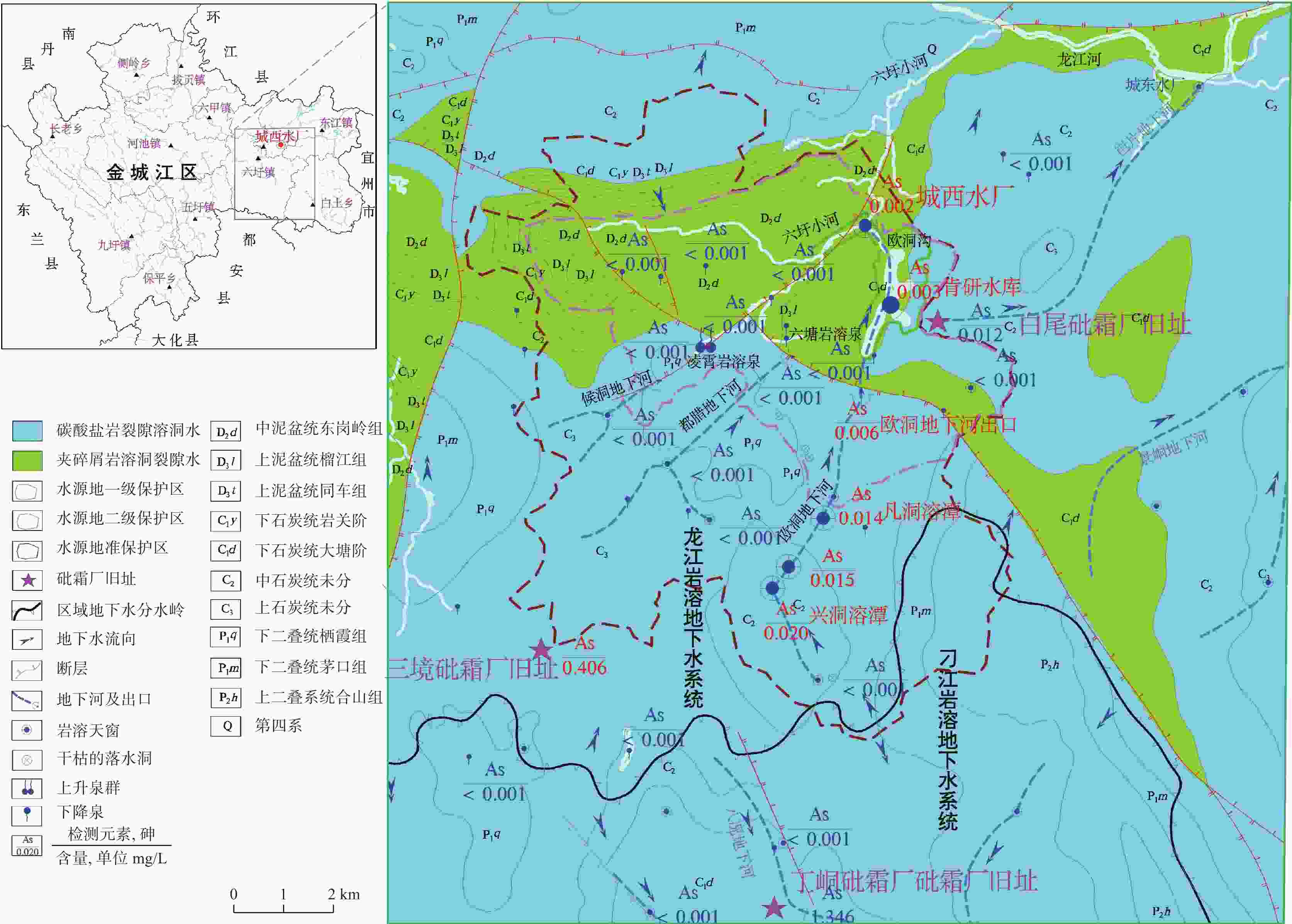
 下载:
下载:
